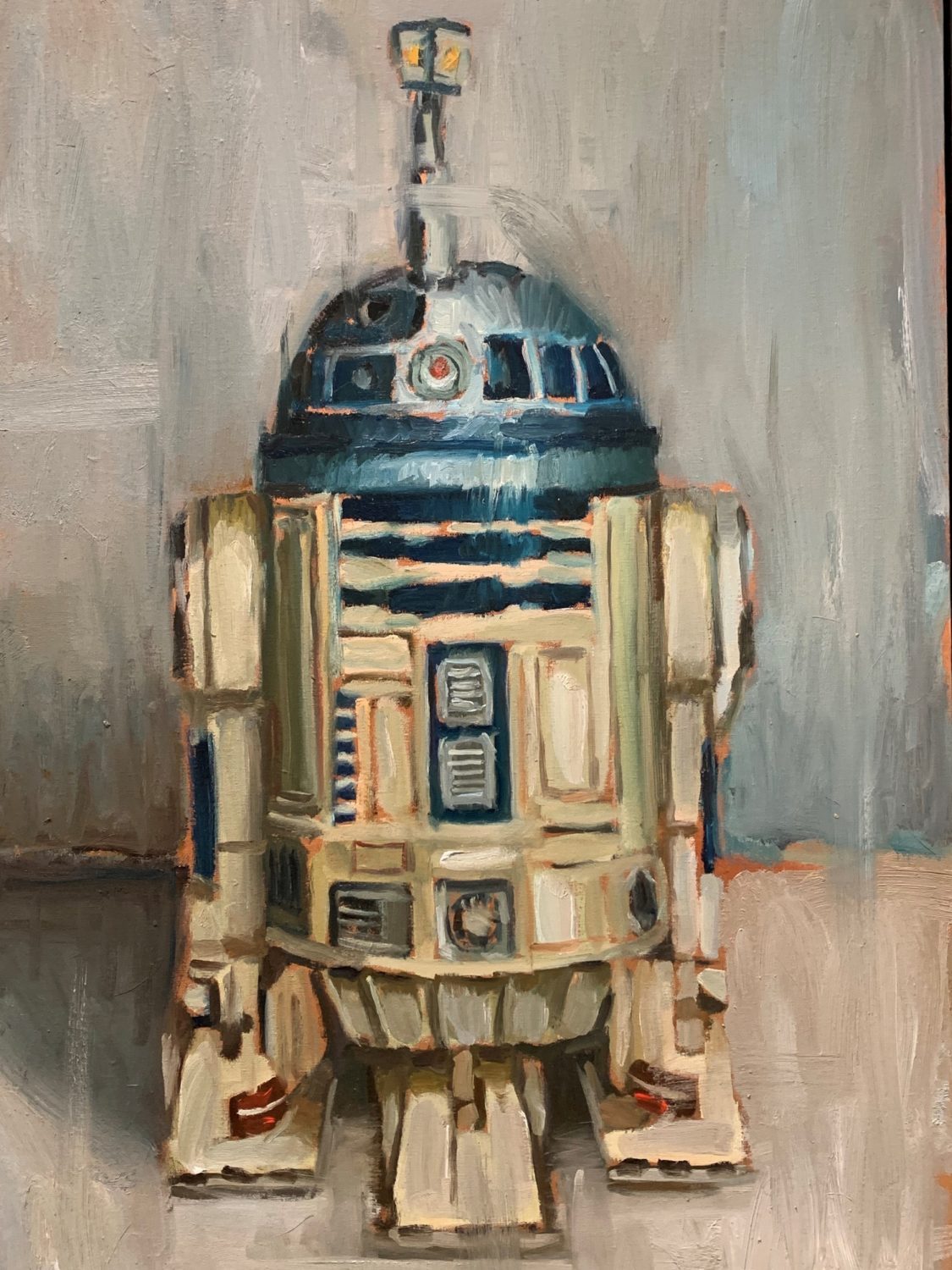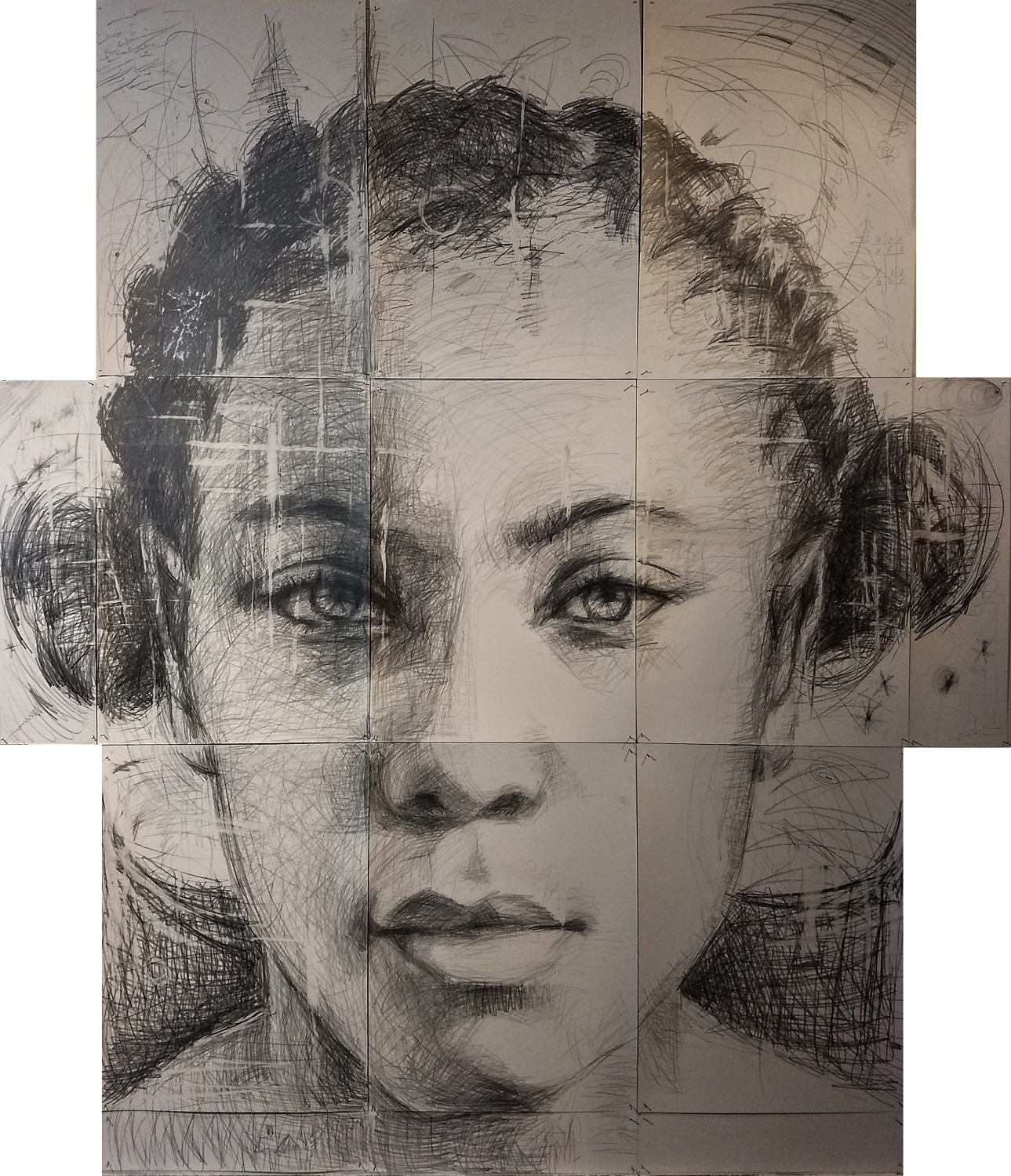Mark Hilbert, co-founder (with his wife Jan) of the Hilbert Museum of California Art on the Chapman University campus in Orange, told me that when he visits a museum, he looks at the visitors there as much as at the art. He observes their reactions to the work on the walls and pedestals, ascertaining how long they spend with individual pieces. Hilbert added that as a museum founder, one of his goals is to encourage visitors to engage deeply with the artwork displayed, to learn about the art movements represented and even about the California history depicted.

“Self-Portrait” – Oil on panel. (William Wray Collection)
It is not surprising that Hilbert, along with curator Gordon McClelland and Hilbert Museum Director Mary Platt, recently installed the exhibition, “Bradford J. Salamon: Forging Ahead,” featuring 47 paintings and drawings. Soon after the exhibition opened in late January, many visitors went there to check it out. Most were so enchanted by the narrative artwork on display, with the vivid, empathetic renderings of people and objects, that they spent long periods gazing at the works.
Salamon uses “expressive lines, colors, shapes, slight exaggerations and focal points to create a statement about the sitters that is more than the sum of its parts and more telling and true than a photograph,” explained Mike McGee, formerly Cal State Fullerton art department chairman.
As a visual storyteller, Salamon revels in creating portraits, scenes and renditions of objects, such as vintage toys and clocks. He explains in the accompanying catalog, “I wanted to do more than just draw everything; along with regular journaling, I was recording my life through drawings and paintings.” He adds, “Staring at a person for several hours a day while painting their portrait gives me an opportunity to really think compassionately about the person and to appreciate another human being on a very deep level. … I also want to give the viewer of the finished work a chance to appreciate the person I have chosen to draw or paint in a more profound way.”

“Animal Style” – Oil on canvas. (The Hilbert Collection)

“R2-D2” – Oil on canvas. (The Donna Vasseghi Collection)
Enhancing Salamon’s work on display are his detailed narratives of his pieces, with many descriptions hearkening back to his childhood – a time that helped form him into a creative, empathetic individual and artist. About his oil, “Betty Boop,” an iconic figure dressed in a hula costume, he wrote, “I find it interesting how our brains select certain experiences to retain as a memory and other experiences we forget. … I don’t know why I painted this of Betty Boop, but I guess it would be because of something I experienced as a child watching cartoons.” About his finely wrought figurative “R2-D2,” he recounted, “’Star Wars’ was such a phenomenon in the late 1970s that it changed the movie industry and our culture in profound and lasting ways.”
Walking through this exhibition becomes a visual and descriptive tour de force, almost like a movie of the artist’s life. The viewer witnesses the work and reads about stories of Salamon’s childhood and teenage years, growing up near the beach, engaging in a variety of adventures, many of which affect his art practice today. His narrative accompanying the expressive, detailed oil, “Notes from a Memory” of three teenagers relaxing against a pool on a summer day reads, “All of us kids back then were free-range kids, largely on our own in the wild. Nicole’s house had this above-ground pool and for a couple of summers it was one of the best spots for us to hang out.”

“Dude Descending a Staircase” – Oil on canvas (Private Collection)
Several paintings have lighter, humorous aspects, the most notable being “Dude Descending a Staircase.” This hilarious, realistic portrayal of Jeff Bridges from the film “The Big Lebowski” depicts him as “The Dude” descending a staircase wearing his rumpled hair and attire. The title is a play on words of Marcel Duchamp’s 1912 salacious painting “Nude Descending a Staircase,” adding a double entendre to Salamon’s work.
Another charmer is “Animal Style,” a succulent close-up of one of In-N-Out Burger’s most popular items. While observing the illustration of burgers with melting cheese, mustard and other mouth-watering accoutrements, the hungry museum visitor might want to visit the famous fast-food joint. Here is also “What, Me Worry?” a detailed three-dimensional illustration of Alfred E. Neuman, Mad Magazine’s mascot. Salamon revealed his interest in current events when he wrote about it, “I can’t help but wonder what Neuman would say about our current political and societal circumstances.”
One style that Salamon excels at is detailed, figurative domestic scenes, often of people he knows posing as themselves. Several such examples include the 2009 “Expectations” of David Michael Lee, a Coastline College educator, relaxing while gazing admiringly at his pregnant wife, Julie Perlin Lee (now executive director, Laguna Art Museum). Also displayed is “White Rabbit” of the artist’s daughter, Lauren, wedged in a doorframe, surrounded by his daughter Sarah, wife Kathy in the kitchen and mother-in-law at the piano. He wrote about this piece, “I included the white rabbit as a reference to procreation.”

“White Rabbit” – Oil on canvas” (Private Collection)
Among Salamon’s personal favorites are his portraits of artist friends – paintings that he has been engaged in for several decades. While his books and catalogs contain many dozen examples of these gems, six of Jodi Bonassi, Alex Couwenberg, Tony DeLap, Llyn Foulkes, Mark Ryden and Don Bachardy are included in this exhibition. The latter of the Santa Monica-based artist relaxing after painting all day is resonant with Salamon, as Bachardy is also a major portrait artist who has portrayed Salamon 23 times. He wrote about Bachardy in his narratives, “He’s a great friend, but he remains also a great hero.”
Salamon’s two most recent portraits, representing his departure in technique, created since the start of the lockdown, are eight-foot-high drawings done with drafting pencil on vellum paper. “Clare V-V #16” is of Clare Dowling, the beautiful daughter of good friend and artist Tom Dowling. “Holly V-V #6” lives in Salamon’s Monrovia neighborhood. “I drew her,” he told me, “because she is an innocent, vulnerable, beautiful girl. And with the Black Lives Matter movement on my mind (Holly is African American), I feel that she represents the future.” I asked him why he creates these new portraits on a larger scale than previously. “Large suggests power,” he said. “And women today need more power.”

“Holly V-V #6” – Drafting pencil on vellum paper (The Hilbert Collection)
Powerful sentiments indeed from an artist who continues to evolve in technique and perspective, for whom portraiture is more than just likeness, and who one day may become as significant and well-known as is David Hockney!
“Bradford J. Salamon: Forging Ahead” is on view through May 7, 2022. Hilbert Museum of California Art, 167 N. Atchison Street, Orange, CA. Tue.–Sat., 11 am–5 pm. 714-516-5880. Free. www.hilbertmuseum.org
Advertising disclosure: We may receive compensation for some of the links in our stories. Thank you for supporting Irvine Weekly and our advertisers.

